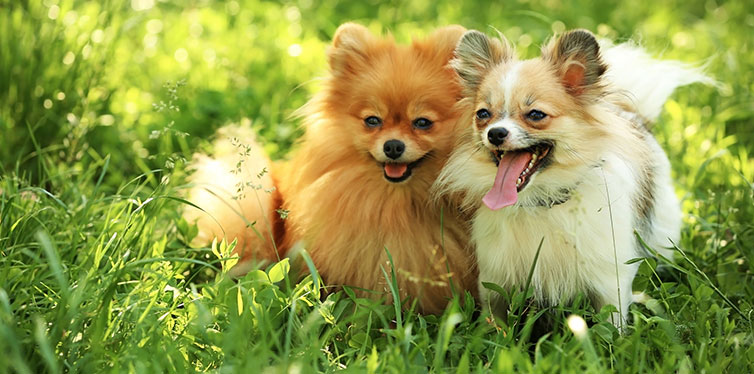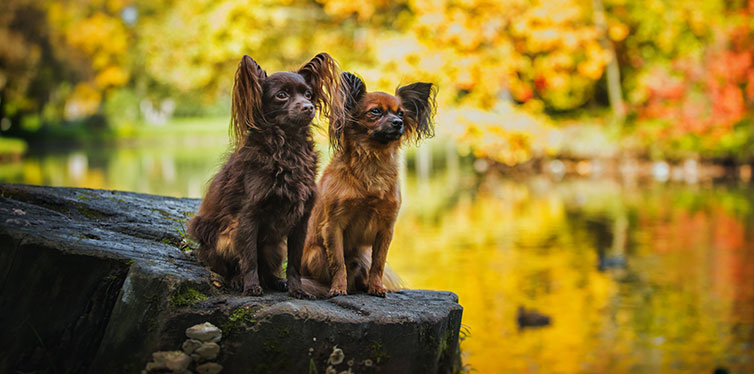Happy, beautiful, and outgoing, the Papillon is one of the most popular toy breed dogs. This adorable and curious pup has a secret though: despite looking quite elegant and refined, it is, in fact, incredibly tough, athletic and long-lived. Already different than most small breed dogs, the Papillon’s main distinction is its large, wing-shaped ears, which give the breed its name (“papillon” means butterfly in French).
Whether you’re considering getting a Papillon dog or you already own one, this article is for you. Here, we cover the history of this unique-looking dog, its temperament, proper diet and exercise, grooming, health, and everything else a (future) Papillon owner should know.
History of the Papillon
Papillon dogs are descendants of European Toy Spaniels. Their history can be traced through various works of art, including Goya, Rembrandt, Vecellio (Titan), Rubens, Watteau and many more. Why were Papillons painted by these renowned artists? Because these gorgeous butterfly eared dogs were originally bred as companion dogs for noblewomen, making them one of the favorite lap dogs in European royal courts. In fact, it is said that Marie Antoinette loved the Papillon more than any other dog (so much that she walked to the guillotine holding her Papillon pet!). To go back even further, a Papillon can be seen in a family portrait of Louis XIV.

But why were Papillons so popular back then, besides being incredibly cute of course? In Renaissance times, people – and especially noblemen and noblewomen – were obsessed with toy and miniature breed dogs. So much that they crossed existing small breeds with spaniels, which is how the Papillon dog was created (the breed’s early ancestors were known as “dwarf spaniels” – that’s how crazy people were about mini breed dogs!). But these early toy spaniels or dwarf spaniels from which the Papillon as we know it today descended had floppy, not upright ears. In the 17th century, in the court of Louis XIV (where the Papillon dog can be seen in family portraits), a tiny spaniel with erect ears was developed and given the name Papillon. Clearly, the name came from the breed’s adorable, butterfly-like ears, so we can consider this the true creation of the Papillon dog breed. Still, the breed was also known by other names over the centuries, including Epagneul Nain (dwarf spaniel), Belgian Toy Spaniel, Dwarf Continental Spaniel, Squirrel Spaniel and a few other. In fact, the Papillon is still referred to as the Epagneul Nain in non-English speaking countries.
The first Papillon was registered by the AKC in 1915, but the breed was not fully represented by their own club until 1935 when the Papillon Club of America (PCA) was created. By the end of the war, the PCA was no longer functioning, but thankfully, it was reactivated in 1948. Then, in 1999, a curious thing happened: Champion Loteki Supernatural Being, also known as Kirby, a Papillon, won all three major international dog shows in the same year. Kirby was also the oldest winner of the Westminister Kennel Club Show. Today, Papillons enjoy not only success in conformation competitive fields, but also in agility and obedience.
Quick Facts
Cute, curious, cheerful and energetic, the “butterfly dog” is a perfect pet companion, be it for singles, couples or families with (older) children. While this dainty-looking pet may be categorized as a lap dog thanks to its size, the Papillon is far from being “shy as a butterfly”– the breed is inquisitive, alert and full of energy, acting more like a true “doggy dog” than a peaceful lap dog. Indeed, it could be said that the Papillon is a large dog in a small body. If you’re thinking of getting one for yourself and/or your family, here are some quick and interesting facts about the breed you may find useful.
- The Papillon has a very long life span –between 12 to 15 years and some can even live up to 17 years. This is a generally healthy breed but, like all other breeds, is one that is prone to certain health problems. In this case, these are hypoglycemia, knee problems and collapsing trachea.
- Papillon dogs come in two varieties: the butterfly Papillon, which has upright ears, and Phalene (“moth” on French), which has floppy ears. Both varieties have the same life span and almost the same litter size.
- While small and dainty-looking, an adult Papillon is a sturdy dog with a hardy constitution. They’re energetic and agile and are known to excel at canine sports. That said, Papillon puppies are fragile and can be injured by rough play, which is Pap puppies are not recommended for families with small children.
- Like many toy breeds, the Papillon dog is sensitive to anesthesia. Keep this in mind when scheduling any surgery or procedure that requires anesthesia.
- This is a companion dog first and foremost, so they will not do well in environments where there is little time for the pet. They don’t like being separated from their human families for extended periods of time.
- Papillons are friendly and outgoing and are known to form strong bonds not only with their human companions but other animals and pets too. They’re the pets to get if you already own other dogs and/or cats.
- The breed is quite intelligent and eager to please as well, so housetraining is generally easy, which is something that cannot be said about many small breeds.
Of course, every dog is different, and your Papillon may have all, some or just one of these traits. This is dependent on the dog’s lineage and how healthy the parents are. To get a healthy Papillon with a sound temperament, make sure you buy it from a responsible and reputable dog breeder who tests their dogs to make sure they’re free from genetic diseases.
Things You Should Know
To keep your Papillon healthy and happy, it’s important to know certain things about the Papillon breed, including their ideal diet, how to train them, groom them and so on.
Training
Papillons are smart and eager to please their owners, so they’re one of the easiest toy breeds to train. This doesn’t mean that they don’t require early obedience and socialization classes though– like any other breed, Papillons too greatly benefit from early training, so do not postpone the classes if you want an obedient and well-behaved Papillon. Consistent training is also crucial – after all, Papillons are small breed dogs who are famous for their disregard of the rules, so keep the training classes regular and consistent. Start training your new pet the very day you bring them home and wait until 10 to 12 weeks of age to get them into puppy training and socialization classes (if possible). Early exposure to various experiences, including other people, animals, sights and sounds, is crucial for forming a steady and well-rounded character.
It’s also a good idea to take your Papillon puppy on regular walks right from the beginning. This way, they will not only have plenty of opportunities to see other dogs and people early on, but also to potty outside. Whenever they act positively, reward them – like most dogs, Papillons thrive on positive reinforcement training. But a word of caution: no matter how adorable, do not overindulge your Papillon as they can get too relaxed too quickly.

Feeding
To stay healthy, Papillons require high-quality dog food that is appropriate for their breed (small or toy) and life stage. Because they’re small, it’s easy to over-feed a Papillon, so do be mindful over the amount of food you’re serving your pet. Ideally, you should feed ¼ to ½ cup of dry dog food a day, split between two meals. Of course, exactly how much food your dog should eat depends on various factors, including their age, lifestyle and activity levels, and also their metabolism and build. If you want to provide the absolute best for your butterfly pup, consult with your vet who can not only recommend a good-quality dog food, but also the exact amount of food your pet should consume on a daily.
Treats are a welcome aid in training, but be careful not to give too many as some Papillons are prone to obesity, especially the not particularly active types.
Grooming
Famous for their long, beautiful and silky coat which comes in several color combinations (with black and white Papillon being the perhaps most popular), Papillons require surprisingly little grooming. This is due to two factors: the fact that they have no undercoat, and that their hair is straight and fine. To be clean and smooth, all they need is infrequent grooming – about once a month – and quick but regular brushing. It’s enough to spend a few minutes once or twice a week brushing Papillon’s coat with a comb or a soft slicker brush to keep the mats away and shine in. You should, however, spend some extra time on brushing certain parts of a Papillon’s body: behind the ears, inside the hind legs and on the culottes or thigh hair as they’re prone to matting there. As for bathing, it’s not required on a frequent basis because Papillons don’t have that typical doggie odor. You can bathe them once every few months or when they get dirty – basically, only when needed.
Like all dogs, Papillons should have their nails trimmed regularly if they live inside the house. About two times a month is all it’s needed to keep them short and neat, although some Paps may need more frequent trimmings. Here is a simple reminder: if you can hear your dog’s nails clicking on the floor, it’s time to cut them.
Because some Papillons are prone to developing periodontal disease, it’s vital that you brush your pet’s teeth regularly – two to three times a week at minimum, or once a day ideally. Of course, you want to make sure you’re using a toothpaste specially formulated for pets and not human toothpaste.
Check out some of our dog grooming guides, such as dog nail clippers, dog toothbrush, dog toothpaste, dog shampoo, and dog shedding brush.
Health
Papillons are generally healthy dogs, but they are prone to certain health problems. Thankfully, not all Paps will get these diseases, but it’s important to be aware of them so you can get a healthy dog from the breeder or seek early treatment if necessary.
- Collapsed trachea: Causes respiratory problems and makes wearing a collar difficult. The condition may be inherited so always buy from reputable and responsible breeders.
- Patellar luxation: This condition causes knee problems (knee caps slipping out of place) and leads to leg lameness or abnormal gait. The condition is present at birth but the luxation typically occurs much later. Severe patellar luxation may require surgery.
- Hypoglycemia: Low blood sugar is a possible problem with all small breed dogs and Paps are no exception. The condition is easily treatable if caught on time but can be fatal if not treated.
- Progressive retinal atrophy: All dogs can have PRA, including Papillons, which is a degenerative eye disorder that eventually leads to blindness. While early detection is possible, there is no cure. Fortunately, dogs with PRA learn to use other senses to compensate for blindness.

Although tough and courageous, Papillons are small dogs, so owners need to be careful with them, especially while they’re puppies. It’s recommended to keep a Papillon puppy away from small children as they can injure the animal easily.
Temperament
Besides being friendly, curious and alert, what is Papillon dog personality like? While all dogs have their special traits and quirks, Papillon’s temperament could best be described as cheerful. These dogs are bright, lively and eager to please, which makes them wonderful companions whether you’re single or you have a big family. That said, a perfect Papillon doesn’t come ready-made from the breeder. Like all animals, they are a product of both nature and nurture, so you should make sure you’re buying from a responsible and reputable breeder first and foremost, and also that you’re training your Pap well.
To be well-behaved and friendly, Papillons require quite a bit of training, as well as early and continuous socialization. If left alone for long periods of time, a negative side of Papillon dog temperament can come out: excessive barking, peeing on carpets, digging in the backyard and various other undesirable behaviors. So, before you get a Papillon, make sure you can devote time and attention to your pet on a regular basis!






